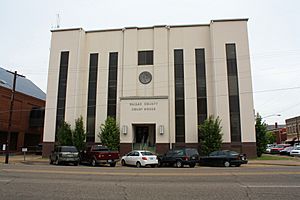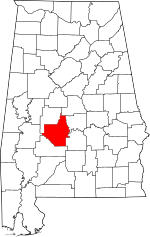Dallas County, Alabama facts for kids
Quick facts for kids
Dallas County
|
||
|---|---|---|

Dallas County Courthouse in Selma. Built in 1901, it was given an extensive modern makeover in 1960
|
||
|
||

Location within the U.S. state of Alabama
|
||
 Alabama's location within the U.S. |
||
| Country | ||
| State | ||
| Founded | February 9, 1818 | |
| Named for | Alexander J. Dallas | |
| Seat | Selma | |
| Largest city | Selma | |
| Area | ||
| • Total | 994 sq mi (2,570 km2) | |
| • Land | 979 sq mi (2,540 km2) | |
| • Water | 15 sq mi (40 km2) 1.5% | |
| Population
(2020)
|
||
| • Total | 38,462 | |
| • Estimate
(2023)
|
36,165 |
|
| • Density | 38.694/sq mi (14.940/km2) | |
| Time zone | UTC−6 (Central) | |
| • Summer (DST) | UTC−5 (CDT) | |
| Congressional district | 7th | |
|
||
Dallas County is a county located in the central part of Alabama, a state in the United States. In 2020, about 38,462 people lived there. The main city and county seat is Selma. The county was named after Alexander J. Dallas, who was an important government official called the United States Secretary of the Treasury from 1814 to 1816.
Dallas County is part of the Selma, AL area, which is a "Micropolitan Statistical Area." This means it's a smaller city area with close ties to nearby communities.
Contents
History of Dallas County
Dallas County was officially created on February 9, 1818. This happened when the Alabama territory was being formed. The land for the county came from Montgomery County. It was part of a large area of land that the Creek people had given to the U.S. government in 1814. The Creek were one of the "Five Civilized Tribes" in the Southeast, known for adopting some American ways of life. The county was named after Alexander J. Dallas, a government leader from Pennsylvania.
The Black Belt and Cotton Farming
Dallas County is in a part of Alabama known as the "Black Belt". This name came from the rich, dark soil that was great for farming. This area became famous for its large cotton farms, called plantations. For many years, enslaved African Americans were forced to work on these plantations.
After slavery ended, many African Americans stayed in the area. They often worked as sharecroppers or tenant farmers. This meant they farmed land owned by others and shared their crops or paid rent. Most people in Dallas County were African American during this time.
Rivers, Towns, and Changes
The Alabama River flows through Dallas County from the northeast to the southwest. The county shares borders with Perry, Chilton, Autauga, Lowndes, Wilcox, and Marengo counties.
The first county seat of Dallas County was Cahaba. For a short time, Cahaba was even the capital city of Alabama! But in 1865, the county seat moved to Selma. Today, Dallas County is still mostly rural, meaning it has more countryside than big cities. Other towns and communities include Marion Junction, Sardis, Orrville, Valley Grande, and Minter.
In the early 1900s, cotton farming faced a big problem: the boll weevil. This small insect damaged cotton plants, making it hard for farmers to grow enough cotton.
Voting Rights and the Great Migration
Around the same time, laws were passed that made it very hard for African Americans to vote. These laws included things like poll taxes (a fee to vote) and literacy tests (tests to prove you could read and write). These rules were designed to stop black citizens and many poor white citizens from voting.
From the late 1800s to the mid-1900s, many African Americans faced unfair treatment. They were often treated as if they were not equal to white people. To escape these difficult conditions, many black families moved from the South to cities in the North and West. This big movement of people is known as the Great Migration.
The Civil Rights Movement in Selma
In the 1950s and 1960s, African Americans across the South began to fight for their right to vote and for equal treatment. Many brave people, including war veterans, worked hard to make changes.
From 1963 to 1965, Selma and Dallas County became a very important place for the Voting Rights Campaign. Local groups like the Dallas County Voters League (DCVL) and student activists from the Student Nonviolent Coordinating Committee (SNCC) organized protests. In late 1964, they asked for help from leaders of the SCLC, including Martin Luther King, Jr..
This campaign gained national and international attention in early 1965. On March 7, hundreds of peaceful marchers tried to walk from Selma to Montgomery, the state capital. As they crossed the Edmund Pettus Bridge, they were met with violence from state troopers and local police. This event, known as "Bloody Sunday," was shown on national television and shocked many people.
The protesters tried again on March 21. This time, thousands of people from all over the country joined them. They also had protection from the federal government. About 25,000 people marched into Montgomery on the last day. Because of these powerful Selma to Montgomery marches, the U.S. Congress passed the Voting Rights Act of 1965 in August of that year. President Lyndon B. Johnson signed it into law. This important law helped millions of African Americans in the South register and vote, allowing them to take part in the political system again.
Geography of Dallas County
The U.S. Census Bureau says that Dallas County covers a total area of 994 square miles (2,570 km²). Out of this, 979 square miles (2,540 km²) is land, and 15 square miles (39 km²) is water. About 1.5% of the county is covered by water.
Counties Nearby
- Chilton County (north)
- Autauga County (northeast)
- Lowndes County (southeast)
- Wilcox County (south)
- Marengo County (west)
- Perry County (northwest)
Protected Natural Areas
- Selma to Montgomery National Historic Trail (part of the trail is in Dallas County)
- Talladega National Forest (a small part of this forest is in the county)
Transportation in Dallas County
Main Roads
 U.S. Highway 80
U.S. Highway 80 State Route 5
State Route 5 State Route 14
State Route 14 State Route 22
State Route 22 State Route 41
State Route 41 State Route 66
State Route 66 State Route 89
State Route 89 State Route 140
State Route 140 State Route 219
State Route 219
Airports
- Craig Field (SEM) in Selma
- Skyharbor Airport (S63) in Selma
Population Information
| Historical population | |||
|---|---|---|---|
| Census | Pop. | %± | |
| 1820 | 6,003 | — | |
| 1830 | 14,017 | 133.5% | |
| 1840 | 25,199 | 79.8% | |
| 1850 | 29,727 | 18.0% | |
| 1860 | 33,625 | 13.1% | |
| 1870 | 40,705 | 21.1% | |
| 1880 | 48,433 | 19.0% | |
| 1890 | 49,350 | 1.9% | |
| 1900 | 54,657 | 10.8% | |
| 1910 | 53,401 | −2.3% | |
| 1920 | 54,697 | 2.4% | |
| 1930 | 55,094 | 0.7% | |
| 1940 | 55,245 | 0.3% | |
| 1950 | 56,270 | 1.9% | |
| 1960 | 56,667 | 0.7% | |
| 1970 | 55,296 | −2.4% | |
| 1980 | 53,981 | −2.4% | |
| 1990 | 48,130 | −10.8% | |
| 2000 | 46,365 | −3.7% | |
| 2010 | 43,820 | −5.5% | |
| 2020 | 38,462 | −12.2% | |
| 2023 (est.) | 36,165 | −17.5% | |
| U.S. Decennial Census 1790–1960 1900–1990 1990–2000 2010–2020 |
|||
In 2020, the census counted 38,462 people living in Dallas County. There were 15,910 households and 10,328 families.
According to the 2020 census, the population of Dallas County was mostly African American. About 69.7% of the people were Black or African American. About 26.9% were White. Smaller groups included people who identified as Native American, Asian, Pacific Islander, or of two or more races. About 0.8% of the population was Hispanic or Latino (who can be of any race).
Education in Dallas County
Schools in areas outside of Selma are part of Dallas County Schools. Schools within the city of Selma are managed by Selma City Schools.
Communities in Dallas County
Cities
- Selma (This is the county seat, meaning it's where the main government offices are.)
- Valley Grande
Towns
Census-designated places
- Selmont-West Selmont (These are areas that are like towns but not officially incorporated as one.)
Unincorporated communities
Ghost town
- Cahaba (A ghost town is a place where people used to live but have now left, often leaving behind empty buildings.)
Notable People from Dallas County
- Kenneth D. McKellar, an American politician who served in the government from Tennessee.
- Redoshi, a woman from Benin, West Africa, who was sadly kidnapped and sold to a slave owner in Dallas County.
See also
 In Spanish: Condado de Dallas (Alabama) para niños
In Spanish: Condado de Dallas (Alabama) para niños


